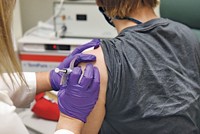Advertisement
Grab your lab coat. Let's get started
Welcome!
Welcome!
Create an account below to get 6 C&EN articles per month, receive newsletters and more - all free.
It seems this is your first time logging in online. Please enter the following information to continue.
As an ACS member you automatically get access to this site. All we need is few more details to create your reading experience.
Not you? Sign in with a different account.
Not you? Sign in with a different account.
ERROR 1
ERROR 1
ERROR 2
ERROR 2
ERROR 2
ERROR 2
ERROR 2
Password and Confirm password must match.
If you have an ACS member number, please enter it here so we can link this account to your membership. (optional)
ERROR 2
ACS values your privacy. By submitting your information, you are gaining access to C&EN and subscribing to our weekly newsletter. We use the information you provide to make your reading experience better, and we will never sell your data to third party members.
Pharmaceuticals
Treating Ebola
Pharmaceuticals: Sparse drug pipeline is unlikely to offer immediate solutions to outbreak
by Lisa M. Jarvis
August 8, 2014
| A version of this story appeared in
Volume 92, Issue 32

As news spread this week that two Americans infected with the Ebola virus have been treated with an experimental antibody cocktail, attention turned to the handful of drugs and vaccines in development to treat the often-fatal illness.
The prospects for effective treatment are poor: Although a few medicines have demonstrated results in primates, none have been tested in humans, and questions remain about how quickly and safely they could be deployed if the outbreak in West Africa expands.
The first case of the current outbreak of Ebola was reported in Guinea in March. As of this week, more than 900 people across West Africa were dead, making this the largest known outbreak of the virus in history. The Ebola virus is transmitted through direct contact with blood or bodily fluids and has a fatality rate as high as 90%, according to the World Health Organization.
Ebola isn’t necessarily more intractable than other viruses, according to Heinz Feldmann, chief of the virology laboratories at NIH’s National Institute of Allergy & Infectious Diseases. But the speed at which infection takes hold poses a challenge for drug developers. “Therapeutic approaches that work after infection have to work very quickly and be very potent,” he says.
The two Americans, who contracted Ebola while working in Liberia, were treated with ZMapp, an experimental antibody mixture developed by San Diego’s Mapp Biopharmaceutical with public and private partners. The treatment was able to clear the infection in primates, which is considered a good proxy for how a drug would work in people.
Two other drugs attracting attention for combatting Ebola are TKM-Ebola, an siRNA-based treatment developed by Tekmira Pharmaceuticals, and AVI-7537, an antisense drug from Sarepta Therapeutics. Both show promise in primates and have undergone safety testing in healthy people.
But both treatments have experienced setbacks. Last month, FDA put a hold on Tekmira’s Phase I study of TKM-Ebola after observing an inflammatory response in test subjects. This week, though, the agency changed the hold to potentially allow the drug to be given to infected people. The Sarepta treatment, meanwhile, was a casualty of cutbacks in Department of Defense funding. In 2012, the government agency pared its program and picked the Tekmira drug to move forward.
Infectious disease experts question whether any of the drugs could be quickly manufactured at the scale needed to fight an epidemic. The antibodies in ZMapp, for example, are grown in tobacco plants and then extracted and purified, a process that can take up to two months. Kentucky BioProcessing, the drug’s contract manufacturer, says it has a limited amount of it on hand. Similarly, Sarepta says it has only enough of the drug to treat a few dozen people.
“Is there enough material?” is the biggest question right now, Feldmann says. Another concern, he says, is that antibodies and RNAi-based therapeutics cost much more to produce than do traditional small molecules.




Join the conversation
Contact the reporter
Submit a Letter to the Editor for publication
Engage with us on Twitter